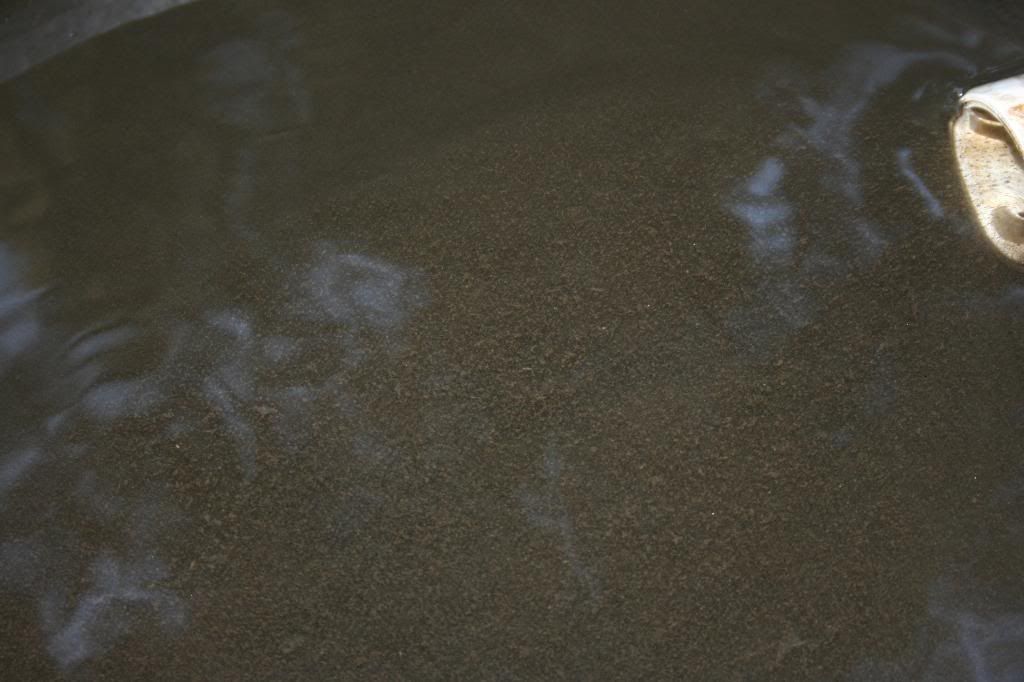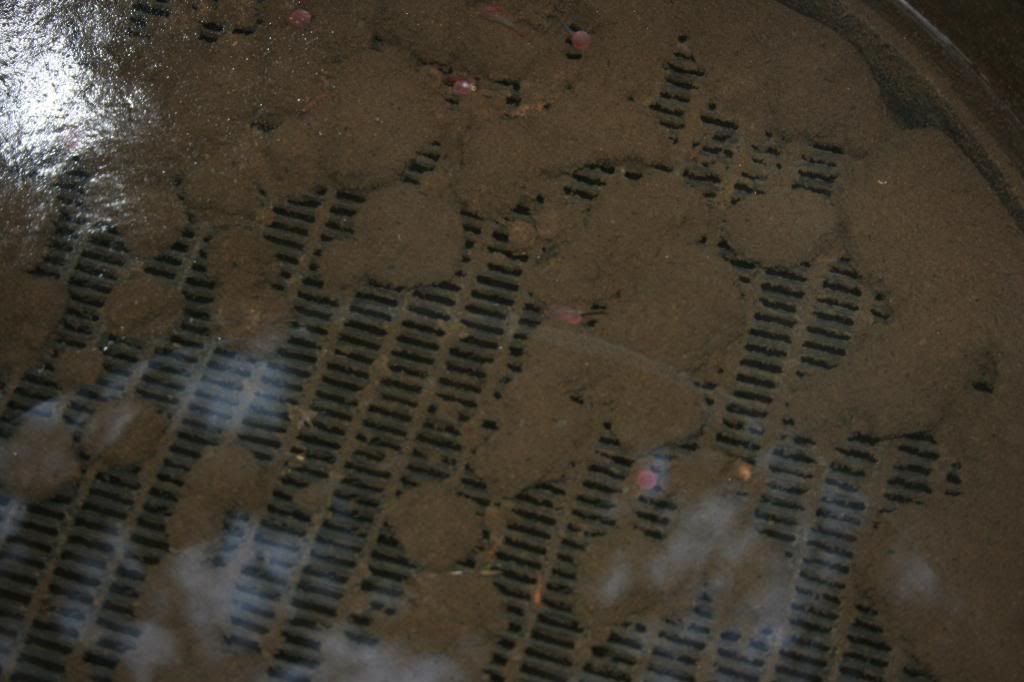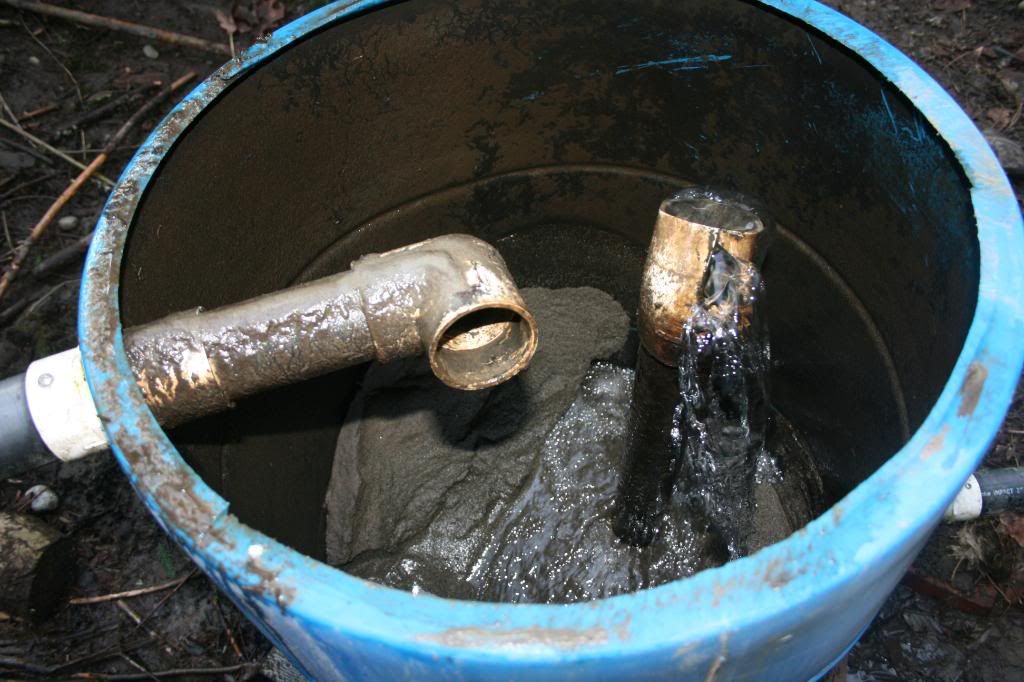I had a general idea what I would be seeing once I took the cover off the incubator. Because the outlet filter slows the water flowing through the incubator quite a bit, things inside get loaded up with silt. The first thing I did then, was to stir the water up with my hand to dislodge as much of that silt as possible. In addition to the silt, there is the organic detritus of the empty egg casings that clutter things up and give the silt a place to rest.

This is what the water looks like as the silt and egg casings are being flushed out of the top of the incubator. You can see the outlet pipe (without the filter screen on it) in the upper right and the silt particles rushing out. If you look closely at the picture, you can see little white patches all over the place. Those are egg casings that are very light and are getting flushed out with the silt.
Once a bunch of that silt had been moved out, I lowered the water level in the incubator temporarily. At first, I thought that I would remove two of the egg trays, leaving the third one in the incubator to keep the bag of plastic media from floating to the surface. In the past, I have taken out all of the egg trays and then watched as the bag of plastic media floated to the surface. Experience has taught me to leave one tray at the bottom. I wanted to remove the trays because they had clumps of eggs on them that had not hatched and those clumps were having two negative effects on the incubator. First, they were starting to rot and having that in the incubator can't be that good for the alevin/fry. Second they slow the water flow down and allow more silt to accumulate in the barrel.

When I lowered the water level, I saw that in addition to the egg clumps (the brownish lumps in the tray) that there were still alevin in the tray. Normally, once the alevin hatch, then squiggle down through the gaps in the tray to the plastic media underneath. If you look carefully at the photo above, you can see at least four alevin. They are the things that look most like salmon eggs in the middle of the picture. Look closely and you can see their eyes, body and tail. Alevin are very fragile. Even brushing against them can kill them at this stage. Because I want as many live fish to survive as possible, I decided to leave the trays in place for another couple of weeks until all of the alevin retreat to the bottom of the barrel.
After I had closed up the incubator, I dropped the cleanout pipe on the clarifier (the blue barrel). This would allow the clarifier to flush out some of the stuff it had accumulated in the past two months. The water/sediment mixture gushing from the pipe had, at first, a dense, dark brown flow which eventually changed to a greyish-brown as time went on.

You can see just how much sediment was trapped in the clarifier. Most of it is sand, some of it is silt. Soil is composed of three types of particles; sand, silt, and clay and then however much organic matter is in the soil. If you were to take a beaker of water and dump in a handful of soil, stir it thoroughly and then watch it for the next several minutes you would see a couple of things. In the first 30 seconds or so, all of the sand particles would fall to the bottom, over the next hour or two all of the silt would drop out of suspension, leaving a fine haze of clay particles in the water. If you had the patience to wait several days, the water would eventually be completely clear and all of the clay particles would have dropped out of suspension as well. The reason they deposit in that order is size and weight, the biggest ones are sand, the smallest ones are clay and those are 80,000 times smaller than the sand grains.
Given that behavior, you can see that the clarifier is mostly filled with sand and a little silt. The incubator gets much more silt. The clay particles pretty much get flushed through the system. As you can see, the clarifier is working. If it wasn't there, all of that sand would get trapped in the bottom of the incubator and eventually cause it to stop flowing because the outlet holes are all the way at the bottom of the barrel and would get blocked first.
So, my mid-season report says that thing are going fine at the McAleer Creek Salmon Circus. It'll be some time in April, a couple of months from now, before we are ready to release. Between now and then, we'll probably look into the barrel a couple more times. Stay tuned.
No comments:
Post a Comment